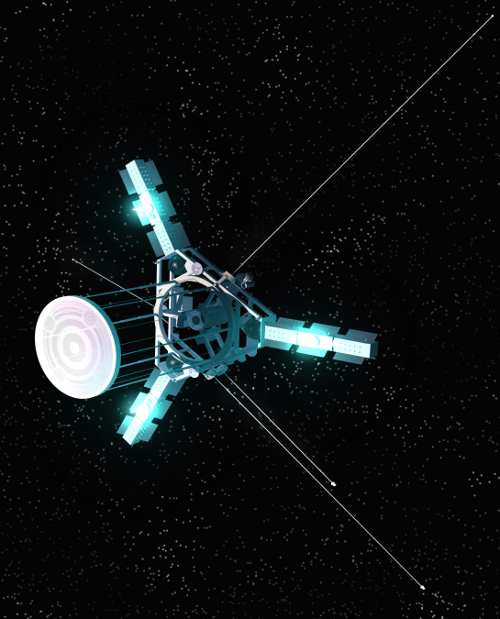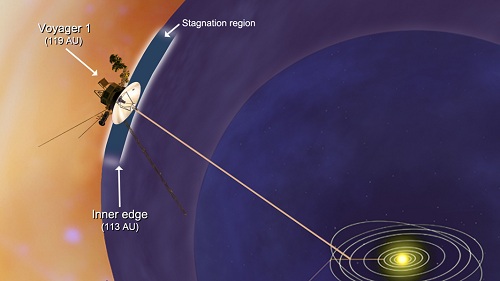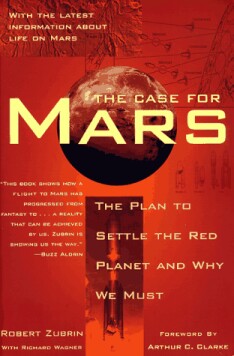Centauri Dreams
Imagining and Planning Interstellar Exploration
Update on Innovative Interstellar Explorer
by Ralph McNutt
Because of the interest that the Innovative Interstellar Explorer mission generates whenever I write about it, I was pleased to receive Ralph McNutt’s latest update on IIE. This was written in response to a recent article in these pages on the Voyager missions and refers to several of the comments in that thread. I first talked to Dr. McNutt about interstellar precursors back in 2003, when researching my Centauri Dreams book. Now at Johns Hopkins University Applied Physics Laboratory, the physicist’s space experience is comprehensive. He is Project Scientist and a Co-Investigator on NASA’s MESSENGER mission to Mercury, Co-Investigator on NASA’s Solar Probe Plus mission to the solar corona, Principal Investigator on the PEPSSI investigation on the New Horizons mission to Pluto, a Co-Investigator for the Voyager PLS and LECP instruments, and a Member of the Ion Neutral Mass Spectrometer Team on the Cassini Orbiter spacecraft. He has published over 150 science and engineering papers and over 250 scientific and engineering abstracts. I’m also pleased to say that he is an active consultant on the Project Icarus interstellar design in addition to continuing the push for an interstellar precursor mission.

Nice article on Voyager on 15 December. With the questions posted about a followup mission, I thought that an update might prove helpful. We are, of course, not currently funded for any work, so this effort remains a loose consortium of interested scientists, engineers, and others. We did present a poster at the recent American Geophysical Union meeting in San Francisco (attached) to update the summary of where all of this is. The current real question is what will be said about the idea of an interstellar probe in the Heliophysics Decadal Survey which should be out in the next few months. NASA science missions have always required prioritization and the current economic climate has made that an even more pressing issue. The fact that restarting Pu-238 production in the U.S. – required for any real mission past Jupiter, to Europa, and for some closer to home as well – has been so difficult is a reflection of the those economic challenges.
One of the recent things we did was to take a quick look at what Falcon Heavy might enable (see poster). SpaceX continues to work hard to bring that – and other products – to market, so the performance is yet to be known in the same detail as that of a Delta IVH. Our look suggests that the advantage may be in the the cost but not the performance. At this time the Delta IVH looks more capable for high-energy Earth escape trajectories, but that could change. The two are certainly in the same class of performance.
To set the record straight, as with Ulysses, we would not have a camera for imaging Jupiter. The Juno and follow-on missions to the Jupiter system would be better for that task. What will be the significant issue with Interstellar probe will be asymptotic speed away from the gravitational pull from the Sun. The key to that performance will be a mass-optimized payload for the primary science of the mission along with a performance optimized propulsion system. Energetic neutral atom imager(s) to look at the interaction of the solar wind and interplanetary medium as well as IR imager(s) to look at the dust environment may be in the cards, but visible imagers will not be – the mass is simply not there.
You are correct that the 2014 window will not be used. That is also related to the prime propulsion question. What is still “on the table” is some combination of large launch vehicle, plus a Jupiter gravity assist, plus (hopefully!) radioisotope propulsion (REP) for 10 to 15 years or a solar sail. Both approaches need additional real engineering study (i.e. study $$s) to pin down better. On paper, a solar sail looks like a potentially better approach: small launch vehicle, high speed out of the solar system, and no worry about (because no advantage from) a Jupiter flyby.
All of that said, I am not at the moment optimistic about using a sail for implementing an interstellar probe. While IKAROS and NanoSail-D have demonstrated sail deployment – a significant technical step – they are a very long way from the characteristics of a sail required for an interstellar probe. The basic requirements can be found here, as those have not changed. A good comparison is Pioneer 10/11 (Pioneer 11 had an additional magnetometer): 258 kg mass (including the instrument payload), 165 W of electrical power (nominal), and a 2.74-m diameter high gain antenna (cf. http://nssdc.gsfc.nasa.gov/nmc/spacecraftDisplay.do?id=1972-012A). Even if payload electronics can be miniaturized to “zero mass” (which they can’t) spacecraft sensor-and-subsystem mass can only be taken so low due to real physical constraints.
So one is likely looking at a 250 kg spacecraft sans sail, a ~400m diameter sail, and still ~1 g/m^2. But to get the required performance, the system will have to tack its way in to ~0.25 AU and then reflect the full solar pressure of the Sun at that distance. The problem is that – as with a probe applying a large delta-V at a close perihelion pass (cf. http://interstellarexplorer.jhuapl.edu/mission/niac_study.html although the link to the NIAC studies is now gone) – there is no way of actually testing this critical part of the mission without actually doing the mission. That is a real problem, which is not going to go away.

Image: An early Innovative Interstellar Explorer design concept. Credit: Ralph McNutt/APL).
The Voyagers will be going “off line” ~2025 as the Pu-238 that powers the subsystems continues to decay. Even for Voyager 1 – the fastest and furthest spacecraft from the Sun (New Horizons will be slower as it continues to climb out of the Sun’s gravity well) – 200 AU will not be reached. It is also worth recalling the cancellation of the initial “Grand Tour” mission due to cost driven by the mission requirement of a 12-year lifetime, replaced by the Voyagers with a 5-year lifetime (and they were almost turned off in 1983-4 because that requirement had been met!).
So 200 AU may be “pretty uninspiring” – but it is still really difficult. Hence, many of us believe that (1) the next step past Voyager needs to be taken and that scientific case can be made, (2) speed is important, and (3) one has to be realistic about what can – and cannot – be accomplished with that next step. A large launch vehicle, upper stage, Jupiter gravity assist, and REP continues – at least to me – to look like the current best bet, but I am always open to practical suggestions. To get to the “interesting” region of the sky as seen by Cassini MIMI and IBEX instruments in the last couple of years, the next window for a Jupiter gravity assist opens in ~2024 – and that could be done.
I hope that this helps to clarify where we are and some of the current thinking. No one ever said any of this is easy.
For further information, see McNutt et al., “Enabling interstellar probe,” Acta Astronautica 68 (2011) 790-801 and McNutt et al., “Interstellar Probe: Impact of the Voyager and IBEX results on science and strategy,” Acta Astronautica 69 (2011) 767-776. Dr. McNutt also sends a link to this video showing the original interstellar precursor concept as developed in studies for NASA’s Institute for Advanced Concepts.

Into the Planetary Rainforest
So-called ‘super-Earths,’ planets larger than the Earth but smaller than Neptune, pose problems to our theories of planet formation. The most recent illustration of this came in the announcement that the candidate planets found by Kepler had now reached 2,326. Remember, many of these will not be confirmed — they’re candidates — but taken in the aggregate, what is interesting here is that one-third to one-half of these candidates fit the super-Earth category. And just as we had a problem with ‘hot Jupiters’ in trying to figure out their orbital position, many of these new planets are likewise in orbits close to their parent star, where the models say they shouldn’t be.
Things seemed so much simpler when we just had a single solar system to worry about, our own. Then, the idea of core accretion could readily account for everything we saw. The dust in the protoplanetary disk was thought to have aggregated into small planetesimals which, in the course of time and numerous collisions, bulked up into planets. It made sense that planets in the inner system would be smaller because the inner part of the disk was thought to have less material for growth, whereas an outer planet would become larger, growing into a gas giant massive enough to pull in a thick atmosphere from the surrounding disk.
As this article by Eric Hand in Nature News points out, the basic model was challenged by finding gas giants in tight orbits, forcing the development of a migration model in which these huge worlds formed out beyond the ‘snow line’ and later made their way into the inner system. Now we have to account for the latest super-Earth findings, as the article points out:
…these models predicted that anything reaching super-Earth size should either become a gas giant or be swallowed by its star, creating a ‘planetary desert’ in this size range. Kepler’s discoveries wreck those predictions. “It’s a tropical rainforest, not a desert,” says Andrew Howard, an astronomer at the University of California, Berkeley. “We hope the theory is going to catch up.”
Hand goes on to talk to Jack Lissauer (NASA Ames), who suggests that some super-Earths could have begun as smaller cores in the outer system that simply never reached the kind of runaway growth that would lead to a Jupiter-class world. Lissauer thinks a planet like this could grow to super-Earth size, and his ideas could explain some of the super-Earths we’ve found with low densities, implying a small rocky core surrounded by a large gas envelope. Even so, we’re still not able to explain denser super-Earths of the kind that are now beginning to be detected.
Kepler’s gradual revelation of smaller and smaller worlds keeps pointing us in the direction of new planet formation models like Norm Murray’s. The astrophysicist (University of Toronto) has tweaked the migration model to have the process of planet formation occur after planetesimals have migrated inward on their own, with the subsequent accretion occurring near the host star. Who knows whether this theory will stand up to the next wave of Kepler results, but if there is one thing we’ve learned from the exoplanet hunt so far, it’s that surprises are abundant, and too doctrinaire a view at this stage is simply asking for revision down the road.

Spaceflight and Legends: A Dialogue with Michael Michaud
I’ve been hoping to publish a dialogue between Michael Michaud and myself ever since talking to him at the 100 Year Starship Symposium and pondering his paper “Long-Term Perspectives on Interstellar Flight.” Centauri Dreams readers will know Michael as the author of the must-have Contact with Alien Civilizations: Our Hopes and Fears about Encountering Extraterrestrials (Springer, 2006), and will also remember his contributions to previous articles in these pages. He has served as director of the U.S. State Department’s Office of Advanced Technology and acted as chairman of working groups at the International Academy of Astronautics that discuss SETI issues, in addition to publishing numerous articles and papers on the implications of contact. In this dialogue, I took some of the elements of his 100 Year Starship presentation and used them as the launching pad for an exploration of how to turn humanity’s attention starward.

PG: Michael, I’ve been going through the paper you presented at the 100 Year Starship Symposium with great interest – it’s packed with ideas! I actually wanted to start this conversation, though, with the quote you used to end the paper. It’s by G. Edward Pendray from a book called The Coming Age of Rocket Power (1945), and you use it to make the point that earlier spaceflight revolutionaries were often guided by a driving sense of purpose and an almost incendiary vision.
Here’s what Pendray says:
“Those of us who have spent years in the study and development of rockets have acquired an emotion about them which is almost religious.
“We somehow feel privileged, as though we had stood in these years at some obscure crossroads in history, and seen the world change. We do not know exactly what we have loosed into the earth, any more than Gutenberg with his movable type, or De Forest with his radio tube. But we feel in our souls that it is magnificent and wonderful, and that the human race will be richer for it in time to come.”
Inspiring words, and especially so when I consider that at the time Pendray was writing, rocketry was associated in the public mind largely with the destruction rained down upon Britain by the V-2 weapon. Pendray is looking beyond this to illuminate the long-term vision of what space could mean, just as von Braun would look beyond the V-2 to the Moon and even to Mars. Hegel said ?’Nothing great has ever been accomplished without passion.’ And you’re saying here that starflight advocates must continue the work to make interstellar exploration seem not just conceivable but necessary for the well being of our species. How then do we instill passion?
In your paper you refer to early pioneers of our current space program as having created a ’legend of events that had not yet occurred,’ saying that this legend then became an expectation. When it comes to things interstellar, we have a number of scientists who are laying down theoretical foundations — Robert Forward is obviously one, as is Alan Bond, and Greg Matloff and several others you cite. Where do we stand today in creating a legend of events for the interstellar idea that will catch hold with the public? Because it’s the ideas we plant while the theoretical underpinnings are being laid down that will help drive the project and fuel that passion.
MM: Paul, in one sense, the original spaceflight revolutionaries had an easier task in inventing a legend of events that have not yet taken place. The physical layout of our solar system offered a series of tangible goals: the ascent to orbit, the orbital station, the Moon, and Mars. The stepwise progression is less obvious in the case of interstellar exploration.
There are, of course, long-term goals for starflight, such as finding evidence of extrasolar life and intelligence, and locating a possible future second home for Humankind. There also are less rational motivations: sharing the excitement of exploration and discovery, appealing to unarticulated hopes and expectations, and suggesting an escape from our present limitations. Without significant events that we cannot foresee, those motivations may not be enough to make starflight a necessary task for current generations of humans.
I suggest that we begin with a focus on the outer solar system. Exploring the more distant realms of the Sun’s empire could be an interim step toward interstellar flight.
There is an acknowledged need that requires a presence there: planetary defense against collisions with asteroids and comet nuclei. Several experts have argued that such a defense requires early warning devices and deflection capabilities in the outer solar system to give us enough time to identify and divert an incoming object.
We need a better understanding of the potentially threatening bodies in the Kuiper Belt and the Oort cloud. We know almost nothing about that cloud, which is vast in extent and is not confined to the ecliptic plane. Some speculate that the outer edge of our Oort cloud may overlap with the outer edge of a nearby star’s cloud.
We may want to reach beyond our known solar system. Astronomers already have found objects at interstellar distances that are smaller and less luminous than familiar types of stars. Dwarf stars, the hulks of burned-out stars, and dark planets ejected from their birth systems may float through interstellar space, possibly closer than the nearest star we know. Whether such an object was potentially threatening or not, it might provide an intermediate goal for interstellar exploration, one that could be reached more easily than known stars.
To encourage thinking outside the box, I speculated in my paper that astronomers studying our Sun might find that our star is evolving more rapidly than they thought, shortening the time between now and an uninhabitable Earth. While this may never happen, it reminds us that we cannot foresee all threats or all opportunities that could motivate interstellar exploration.
There are ways of looking at this question that may appeal more to scientific and engineering audiences. One that already is being addressed in the interstellar community is conceiving engines that could power a starship to a useful velocity. A breakthrough on propulsion could have implications for energy technology reaching beyond starflight.
An interstellar probe that will be under way for decades and that will face complex tasks in the target system must include a highly sophisticated onboard artificial intelligence, one that will never return to the Earth. I suggest that scientists and engineers seize the opportunity to create the most autonomous artificial intelligence ever made, sending it where it will be the least dangerous to Humankind.
Perhaps you or your readers will come up with a better legend of events that have not yet taken place. Let me know your thoughts.

PG: I do know we need legends, because you recognize in your paper that while some people do accept what you call the outward-looking paradigms of exploration and expansion, most people do not. I think the question many of the latter would ask is whether the very idea of starflight isn’t a vast over-reach given the mind-numbing distances involved and the relative ineffectiveness of our technology at surmounting them. If we’re to build a case for the interstellar future, we need to address those long-term motivations that awaken understanding and kindle enthusiasm to make sure the public gets behind this enterprise.
But I take your point, Michael. Interstellar flight is sharply different from von Braun’s interplanetary ideas. The latter came with the expecation that they could be accomplished in mere decades. If we follow your lead and look to the outer Solar System for a cue, then interstellar precursor missions should become a driver, especially as they relate to the perceived need for planetary defense. Your AI idea fits right into this — can we produce a spacecraft guided by the most sophisticated artificial intelligence ever made and send it out there, as the vanguard of our efforts to build up a deep space infrastructure?
This could be seen as a near-future legend, in that advances in artificial intelligence could become quite interesting for this purpose within the next few decades. Meanwhile, we’re beginning to test the solar sail technology that could propel a precursor mission to study the outer reaches and help us tune up our propulsion options for getting to threatening objects while they are still far from Earth. Von Braun’s great Mars project grew up in an era when Cold War tensions were high, so the notion of a threat gets peoples’ attention. In this case, the threat is not militaristic but natural in the form of rogue objects. Shaping the threat is how little we know about not just the Kuiper Belt but, as you say, the dynamics of the cometary cloud surrounding the Solar System.
So maybe that’s our legend. We need something like Ralph McNutt’s Innovative Interstellar Explorer, but a precursor mission tuned up to serve as a technology testbed for both propulsion and artificial intelligence. That legend would involve continuing our drive toward solar sails, just as the von Braun legend involved building ever larger chemical rockets. It would also include space-based telescopes for identifying potential threats and would throw in the human passion for exploration as we pushed our probes deeper into the system. The wild card here may well be the identification of a brown dwarf closer than the Alpha Centauri stars.
But here’s the catch. In your paper you give a series of recommendations about how the interstellar community should move forward. The most striking is the one you and I both agree on — leave human beings out of the equation. I’m convinced that manned missions to the outer Solar System are out of the question in the near-term, but our need for planetary defense isn’t going to wait. If deep space journeys are to be flown using robotics alone, can we sell that concept to the public? Is the reason von Braun caught hold for so long the fact that he envisioned people landing in the broad desert of a Bonestell Mars?
MM: Paul, you are right about the vision of people landing on a Bonestell Mars being an important part of von Braun’s appeal. It still is.
When we talk about legends of events that have not yet taken place, we should include expectations of what our exploring spacecraft might find. Imagery produced by space artists and other illustrators played a major role in creating expectations about what the first generations of space missions would reveal. Chesley Bonestell (and before him, Lucien Rudaux) gave us pictures of other worlds in our solar system long before our machines arrived there. While some of those images were based on faulty assumptions (e.g. canals on Mars), they stimulated intense curiosity. (I was first inspired by Willy Ley’s 1949 book The Conquest of Space, illustrated by Bonestell). Present-day artists and illustrators can use many more sophisticated tools to create fascinating imagery. We already are seeing imaginative variety in artist’s conceptions of planets orbiting other stars – the presumed targets of our interstellar probes.
One factor that drew many people to the first generation of space exploration was the power of the rocket, which was the basis for Von Braun’s conceptions. We all recognize now that chemical propulsion will not be adequate for missions beyond our solar system. While solar sailing has an esthetic attraction, it is a slow means of transport. We need another paradigm of power, perhaps based on fusion.
What events can we anticipate that might help or hinder the interstellar idea? The most obvious one would be the discovery of an Earthlike planet orbiting a nearby star. Another may seem at first glance like a negative: cutbacks in the budgets of space and research agencies for several years. Such cuts could lead to fewer or smaller missions, and longer gaps between them.
I suggest that we look at this another way. Mission planners and spacecraft engineers will have a powerful incentive to give their machines longer useful lifetimes. Instead of three years, why not twenty? The users of those spacecraft (such as principal investigators) also may have to adopt longer-term perspectives for their work. Those small steps into deeper time will be needed when we begin interstellar exploration.
Over to you.

PG: I’m always glad to talk to someone who understands how to make a virtue of necessity, or as they say, turn lemons into lemonade. I think this is a positive perspective on an unavoidable problem: If we’re constrained by budgets and economies to have fewer and smaller missions, then let’s see what we can learn about making the next generation of spacecraft that much more robust, so we get more out of them over a longer period. If the effect of this is indeed to give principal investigators a bit of perspective into a deeper time strategy — if we start thinking in terms not of 40-year mission maxima but fifty or sixty, so much the better.
In your paper at the 100 Year Starship Symposium, you also note that serendipitous events can come along at any time and have substantial effect. Few would have assumed as World War II ground down that it would be followed by decades of Cold War, but geopolitics played a huge hand in getting the superpowers to turn their attention to space, considering it in terms of national prestige. And the exoplanets we’re finding by the day are having an effect in awakening the general public to the idea of interstellar travel. In fact, whenever I’m asked about this or that exoplanet, the invariable next question is, when would we be able to go there?
We don’t know what might happen next, but we have the example of the two Voyagers to help us see that long-term continuity in space exploration is already underway. Voyager tells us that we can build craft that last a long time, and that the idea of a decades or century-long mission to another star isn’t out of the question in terms of equipment reliability. I suspect the failure of SETI to find an extraterrestrial civilization in tandem with the discovery of a habitable world within 20 light years of the Sun — if such a world indeed exists (and Claudio Maccone’s statistical analyses on the matter say that it’s barely possible) — would be a powerful boost in building an interstellar consensus among the public. The kind of consensus that could one day lead to a mission.
After all, it may take a probe to answer once and for all whether life is out there. And a planet with all the characteristics for supporting life as we know it that shows a possible biosignature may be our most likely chance to find completely alien lifeforms, even if they’re not intelligent. Curiosity growing out of astronomy, SETI, and our need to explore may come together in what you have called ‘an unarticulated grand strategy’ that gives shape to our place in the universe, and within which our shared interests in species survival can play a major role.
I’ll let you have the last word, Michael, with profound thanks for your insights. We can close on this question: In the largest possible time-frame, you’ve written that interstellar flight may be the way intelligence escapes stellar evolution. If we never find another civilization among the stars, is interstellar flight a matter of moral obligation to make sure that intelligence survives in the galaxy?
MM: Though I am one of the many who support the scientific search for extraterrestrial intelligence, we should recognize that Earth-based searches may fail to detect confirmed evidence of another civilization in the foreseeable future. That would not prove the absence of intelligence elsewhere, but it could discourage those who hope for inspiration or assistance from an extraterrestrial source. Even if alien civilizations do exist somewhere in the galaxy, our inability to find them with our existing technologies might leave us effectively alone. We would have to solve our own problems to assure our own future. That could help to revive the anthropocentrism that SETI has challenged for half a century.
I agree with your idea that coupling a SETI failure with the discovery of a habitable planet within 20 light years could generate a paradigm shift, to a belief that we might call anthropocentrism with a goal. Taking charge of our own future would include, in the long term, peopling another world.
This legend of events that have not yet taken place already exists for consumers of science fiction and futurist speculation. Authors and film-makers have given us many visions of an expanded humanity, though not all are happy.
We do not know if other sapient beings escape the evolution of their stars. Perhaps few do. We may have an opportunity to claim an exceptionalist status, but only if we take the necessary actions.
You and I will not live to see the first interstellar probe launched, much less the first inhabited human starship. Yet I would wager that we both feel responsible for doing what we can to improve the prospects of our descendants. Encouraging wider support for early work on interstellar craft is a small but needed contribution.
The moral obligation to assure the survival of intelligence is not imposed on us by gods or prophets, but by our own choices. Call that anthropocentrism if you will. I prefer to think of us as independent moral agents, perhaps the only ones in the galaxy. Until and unless we discover another technological civilization, we have a unique responsibility to impose intention on chance.

Voyager in the Doldrums
One of the pleasures of writing Centauri Dreams is digging into a paper to look at it from various directions, as I did recently with Jim Benford’s work on cost-optimized beamed sails. Jim has been working on these concepts for a long time, and although I had originally intended to devote two days to his latest, the depth of his analysis led me to extend the discussion to a third day. That kind of focus invariably means I get behind in other stories, though, so I want to be sure to catch up with matters like the recent news about the Voyagers as they continue to exit our system.
I always point to the still functioning instruments of the Voyagers as an outstanding example of how we can build spacecraft for the long haul — these tough platforms show what can be done with careful design, and future craft fully optimized for even longer flights certainly seem practical. In this case, three instrument packages — the Cosmic Ray Subsystem, the Magnetometer and the Low Energy Charged Particle instrument — have told us that Voyager 1 is now in the doldrums of the Solar System, a place at the outer edge of the heliosphere where the solar wind has dropped to zero and the magnetic field is being compacted and intensified.
Image: Image: NASA’s Voyager 1 spacecraft has entered a new region between our solar system and interstellar space, which scientists are calling the stagnation region. In the stagnation region, the wind of charged particles streaming out from our sun has slowed and turned inward for the first time, our solar system’s magnetic field has piled up and higher-energy particles from inside our solar system appear to be leaking out into interstellar space. This image shows that the inner edge of the stagnation region is located about 113 astronomical units (10.5 billion miles or 16.9 billion kilometers) from the sun. Voyager 1 is currently about 119 astronomical units (11 billion miles or 17.8 billion kilometers) from the sun. The distance to the outer edge is unknown. Credit: NASA/JPL.
At the same time, Voyager has seen the energetic particles from within our system declining, now about half as abundant as they had been during the past five years, while the intensity of high-energy electrons from elsewhere in the galaxy is up 100-fold. All of this adds up to the approach of true interstellar space. Here’s Rob Decker, a Voyager Low-Energy Charged Particle Instrument co-investigator (JHU/APL):
“We’ve been using the flow of energetic charged particles at Voyager 1 as a kind of wind sock to estimate the solar wind velocity. We’ve found that the wind speeds are low in this region and gust erratically. For the first time, the wind even blows back at us. We are evidently traveling in completely new territory. Scientists had suggested previously that there might be a stagnation layer, but we weren’t sure it existed until now.”
Out of the doldrums and into interstellar space, where the winds are galactic — what an outcome for the twin craft launched in 1977. The new findings were announced at the at the American Geophysical Union’s fall meeting in San Francisco, and we can count on the Voyagers staying in the news for a while longer, as the boundary they’re crossing may take no more than a few months — or several years — to transit. Where next after Voyager? Ralph McNutt’s Innovative Interstellar Explorer is a robust take on an interstellar precursor mission that would be the logical follow-up, a mission study that could put instruments out to 200 AU and test numerous technologies. Let’s hope IIE finds the support it will need to turn it into actual hardware.

Notes & Queries 12/14/11
I normally scan through various news items for the Notes & Queries posts, but in this case I’ve been trying to catch up on my reading. In particular, I’ve been looking at books that could be useful in inspiring young people to get interested in astronomy and engineering. Here’s a look at three titles that more or less fit that bill. The budding rocket scientist will love the revised Zubrin, particularly with its infectious and expansive sense of what’s possible, but younger students may find their minds tweaked by the two other selections, both of which I’d recommend for a high-school audience. We never know what can launch a career, but scientists are always reminding me of particular books they read when they were kids that made all the difference.
Back to the Red Planet
Toward the end of Robert Zubrin’s The Case for Mars (revised edition, 2011), the author looks at three possible models for getting humans to the Red Planet. It’s a significant section because Zubrin recognizes the political and economic realities of our time, and knows that to make something audacious happen in space will require either a commitment from government of the kind we haven’t seen in decades or a substantial infusion of interest from the commercial sector.
Zubrin’s ‘JFK Model’ is what you would expect, a call upon America to rise to the challenge of interplanetary flight. It would involve the nation embarking on what he thinks would be a $30 billion program that would create jobs and spin off technologies while reinvigorating the exploratory spirit. The rival ‘Sagan Model’ would be an explicitly international effort drawing upon collaboration from all space-faring nations, with the potential benefit of easing global tensions in pursuit of a common goal. Finally, the ‘Gingrich Model’ draws on Zubrin’s conversations with the former Speaker of the House, which resulted in Zubrin’s working out a Mars prize that would be funded by government but would result in intense commercial competition for a privately-built mission. All three are out of vogue given the economic realities, but the case for each is interesting, and the right approach could wind up saving quite a bit of money.
For Zubrin is able to get the numbers down even lower than the surprising $30 billion he discusses for the JFK model by using the private sector’s various economies. He’s a persistent critic of government waste with a career in aerospace that has taught him how it happens:
…the major aerospace companies contract with the government to do a job on a ‘cost plus’ basis, which means that whatever it costs them to do the job, they charge the government a certain percentage more, usually 8 to 12 percent. Therefore, the more it costs the major aerospace companies to do a job for the government, the more money they make. For this reason their staffs are top heavy with layer after layer of useless, high-priced ‘matrix managers’ (who manage nothing), ‘marketeers’ (who do no marketing), and ‘planners’ (whose plans are never used) and whose sole apparent function is to add to company overhead. Of course, since the government needs proof that the expenses claimed by the aerospace companies are actually being incurred, vast numbers of accounting personnel are also employed, to keep track of how many labor hours are spent on each and every separate contract. To give you an idea of how bad it is, at Lockheed Martin’s main plant in Denver, where I used to work, and where the Titan and Atlas launch vehicles are produced, only a small minority of all personnel actually work in the factory. The fact that Lockheed Martin is cost competitive with the other large aerospace companies indicates that the rest of them are operating with similar overhead burdens as well.
A new kind of aerospace industry based on minimum-cost production methods — this is what you get by posting multi-billion dollar prizes of fixed amount for breakthrough space accomplishments — is one way to make a Mars mission more tenable than the $450 billion colossus once estimated to pay for President Bush’s 1989 Mars initiative. The logistical nightmare created by multiple launches, on-orbit assembly and propellant-hauling to the Red Planet seemed to define our prospects until Zubrin started attacking those numbers with refreshing new concepts. He also supplies a philosophical case for making them happen.
The Case for Mars was a bracing read when it appeared and its revised version has the same combination of exuberance and inventive zeal that resulted in Mars Direct, a plan that uses technology we have today to land fuel factories on Mars that would supply later manned missions with what they need to get back to Earth. Those of us with an interstellar bent will appreciate Zubrin’s tireless work in favor of a human future off-planet. Whether you’re coming to The Case for Mars for the first time or read it when it first appeared, the new version is worth your time. Travel light, live off the land, make it happen now — that’s the spirit invoked here, which is why Sagan once wrote “Bob Zubrin really, nearly alone, changed our thinking on this issue.”
Reaching the Budding Scientist
The Japanese form of comic art known as manga seems a surprising way to teach tough concepts, and I was more than skeptical when I first took a look at The Manga Guide to Relativity and The Manga Guide to the Universe (No Starch Press, 2011). But these are cleverly designed books, co-published with the technical publishing house Ohmsha in Tokyo and part of a Manga Guide series devoted to technical and scientific subjects. Each guide is written by a specialist in its field and illustrated by a professional manga artist. I started thumbing through the Manga Guide to Relativity and found myself drawn into a storyline that fed into the deeper content.
I’m thinking these guides would be a good way to reach young people with an approachable story that leads to some meaty physics. In the relativity book, a student is challenged to pick up the basics of special and general relativity over the course of a summer and works his way through these with an attractive young teacher who teases and prods him into understanding. The book alternates between manga and written text and manages to work through everything from time dilation to the twin paradox, examining why length contracts and mass increases at relativistic speeds and how mass affects spacetime, with results we can measure. I won’t say that the concepts here are taught painlessly — Einstein puts plenty of demands upon anyone’s imagination — but they’re creatively presented and made exciting.
The Manga Guide to the Universe is a thicker volume that takes three high school girls through a course in basic astronomy and astrophysics, with the aid of a kindly professor and the context of a play they are trying to present. The alternating manga and text cover theories of the universe’s origin and the discoveries that helped us understand its scale, working up to the cosmological microwave background and the mysteries of dark matter and dark energy. There’s enough meaty concepts here to challenge a young student and perhaps fill his or her head with ideas that might lead to a career. The Manga Guides aren’t textbooks in the classic sense, but you could consider them enticements, keys that might unlock much tougher texts down the road.
A TV Universe Now in Print
If I were trying to inspire young people with the beauties of astrophysics, I’d also make sure to show them Brian Cox’s Wonders of the Universe (HarperDesign, 2011). This is a superb coffee-table book with the kind of gorgeous photography I associate with large, glossy science books, but it’s also a well-written and thoughtful presentation of current thinking on the cosmos. Cox (University of Manchester) is a particle physicist who has brought his teaching skills to the fore in a television show of the same name. A keyboardist in the UK pop band D:Ream in the 1990s, he brings a certain brio to the task that never undercuts the clarity of his exposition.
I also see him compared to Carl Sagan, which seems relatively apt given that both were gifted popularizers who could make difficult concepts accessible. For the book and TV series, Cox was able to travel to exotic locations around the globe to make his points, going to the Valley of the Kings, for example, to talk about celestial alignments and ancient concepts of the heavens, or to the Bagmati River in Nepal, where he sees the funeral pyres that line its banks and discusses the Hindu beliefs about the recycling of the elements, a line of thought that will lead him on to examine the death of stars and the explosive birth of new elements.
The photographs and diagrams truly carry this book, but Cox gets across the wonder of what he does for a living, as he does here in a bit once again reminiscent of Sagan (in Pale Blue Dot):
Our story is the story of the Universe. Every piece of every one and every thing you love, of every thing you hate, of every thing you hold precious, was assembled in the first few minutes of the life of the Universe, and transformed in the hearts of stars or created in their fiery deaths. When you die those pieces will be returned to the Universe in the endless cycle of death and rebirth. What a wonderful thing to be a part of that universe – and what a story. What a majestic story!
All of this in large print on the side of a double-page spread showing an artist’s conception of a supernova that blazes out in fantastic wraiths of color. This kind of thing makes for good TV and it’s solidly expressed in the text, which offers a crash course on our latest discoveries in the cosmos even as it sketches in the historical contributions that have gotten us to our current understanding. I would aim this book at the student who has already decided he or she is interested in the heavens and wants to learn more. Reading through Cox’s description of entropy — as he walks the sands of the Namibian desert and uses the ruined structures of old settlements to explain it — connects theory with the palpable world in ways that can reach young minds.

A Path Forward for Beamed Sails
Minimizing the cost of a project is no small matter because, as Jim Benford points out in the paper we’ve been examining over the past several days, cost determines how we decide on competing claims for resources. In the case of a beamed sail mission and its infrastructure, the cost is largely the reusable launcher or ‘beamer,’ which is the beam source and the antennae needed to radiate the beam. Benford is able to derive general relations for cost-optimal transmitter aperture and beam power, from which he can estimate capital cost and operating cost using today’s parameters. He can then study the economics of high-volume manufacturing.

How to get from today’s economics to tomorrow’s? This is where the concept of the ‘learning curve’ comes into play — it is the decrease in unit cost of hardware with increased production. A 90 percent learning curve means that the cost of a second item is 90 percent the cost of the first, while the fourth is 90 percent the cost of the second, and as Benford explains, the 2Nth item is 90 percent of the cost of the Nth item. Usefully, the author notes that the learning curve in power-beaming technologies is well documented. Antennae and microwave sources have an 85 percent learning curve based on large-scale production of antennae, magnetrons, klystrons, etc.
Image: Jim Benford, whose focus on beam-powered propulsion led to the first laboratory demonstrations of microwave-driven carbon sails and showed their ‘beam-riding’ stability under power.
Yesterday we saw these principles applied to an interstellar precursor mission, a 1-kilometer sail moving at 63 kilometers per second, and found that a capital cost of $144 billion could be reduced to $21.6 billion as we factor in economies of scale. But consider how intractable a true starship moving at 10 percent of the speed of light is even when all factors are cost-optimized. Here’s we’re pushing up against serious problems, not the least of which is the high acceleration demanded, about 50 g’s at an acceleration distance of roughly 1 AU. As we’ve seen with beamed sail concepts, acceleration is strongly temperature-limited. As Benford writes:
Not even carbon can survive the heating due to absorption at this acceleration. Sail reflectivity would have to be close to perfect to allow such acceleration. How to change this concept, via the assumed parameters, to bring down the acceleration is left as an exercise for the reader. Cost is in the T$ range, even with economies of scale, and is larger than any past human project.
Some (but not all) of Benford’s observations based on applying cost-optimized scaling to beamed sails:
- Given that the highest costs are found in the antenna and power source elements, it’s important to note that both are proportional to velocity, transmitter diameter and frequency. Costs can therefore be reduced through larger sails, lower mass sails, and higher frequencies.
- Reducing the cost of power will be more important than reducing the cost of antennae.
- Halving the transit time by doubling the speed will cost 2.5 times as much.
Charting a way forward for directed energy propulsion involves building on what we already have by working through a sequence of applications. To make power beaming economic, we need to move power from places where it is cheap to places where it is scarce:
Previous work has shown that it is often more economical to transmit power than to move the equipment to produce power locally. Modern power systems are complex, but if power for space can be located where it is easily accessible and adjacent to where the required skilled people are located, i.e., on Earth, then it becomes more practical.
We use microwave and millimeter-wave antennae in astronomy already, and gyrotron sources at high frequencies are being developed for fusion. Benford thinks that orbital debris mapping could be an early objective, as could recharging of satellite batteries in LEO and, eventually, GEO. He also notes microwave thermal thruster concepts that could provide economical launches of supply modules to low-Earth orbit. Given the economic realities, it is clear that technology development must demonstrate commercial applicability, incremental commercial growth in these areas leading to a space-based infrastructure.
Beamed propulsion offers one path to precursor and eventual interstellar missions. What Benford has been tackling in this paper are the questions of engineering and cost that take economies of scale into consideration. But he also notes that we need to apply this kind of cost analysis not only to past interstellar mission designs, many of which could presumably be improved by working out cost issues, but also to that other possible application of sails — as a method for decelerating a probe when it approaches a destination stellar system. In the broadest sense, determining what is feasible not only in physics but also in economics makes our interstellar thinking more focused and provides needed tools for assessing new concepts.
The paper is J. Benford, “Starship Sails Propelled by Cost-Optimized Directed Energy.” The paper is now available on the arXiv site.







